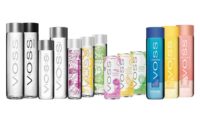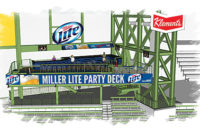![]()
Cabazon Takes the ‘LEED’
Nestlé
Waters’ Cabazon, Calif., plant is one of the company’s newest
facilities, and was built with both high performance production goals and
environmental considerations in mind. This summer, the plant received a
Silver rating from the Leadership in Energy & Environmental Design
(LEED) program of the U.S. Green Building Council, making it the first food
manufacturing plant and one of only a few industrial facilities in the
country to earn the distinction.
The Cabazon plant is located between Palm Springs and
Los Angeles on reservation land owned by the Morongo Band of Mission
Indians. A sustainable design was important to
both parties, says Operations Manager Mike Franceschetti: “With the
tribe as our partner, it was the goal from the very concept [of the plant].
They’re very environmentally conscious.”
The plant opened in April 2003, and includes a number
of “green” features such as recycled construction materials,
energy-efficient systems and water-saving fixtures — and it’s
managed to do so while maintaining the high-speed operations expected of
today’s Nestlé Waters plants.
Bottled at the source
The 390,000-square foot Cabazon facility is located at
the base of the mountain from which it sources spring water, and produces
Arrowhead brand spring water, and occasionally, the Nestlé Pure Life
brand. It houses five and a half bottling lines and produces 24 million
cases per year.
To avoid extra shipping costs, Nestlé Waters
prefers to keep bottling operations as close as possible to the final
product destination so some of the water from Cabazon’s spring is
hauled by tanker trucks to other California plants, and some is bottled
onsite. Water from the spring is pumped to the facility and held in three
60,000-gallon silos outside the plant.
Once inside the plant, the water undergoes two micro-filtration processes — once to remove particles such as sand that might have come
in from the outside, and once to ensure it is free from any
micro-organisms. The water then goes through ultraviolet treatment as a
final safety measure. Filtering operations are located at each bottling
line, allowing the water to move straight from filtration to the bottling
line.
Filtration and other quality measures are performed by
the quality control department, which frequently tests for things such as
total dissolved solids (TDS), turbidity, pH, bacteria and water levels in
the silos. It also is responsible for the plant’s clean-in-place
(CIP) sanitation system.
“We monitor [the water] all the time —
before the filters, after the filters, in the silos, on the
lines…” says Quality Manager Judie Chapman.
“QA has a pretty important job because they not
only check all the water to make sure it’s within specification, but
they also make sure there is plenty of water to go to all the other
facilities.”
Vertically integrated
Like Nestlé Waters Hollis, Maine, plant, the
Cabazon facility not only blowmolds its own
bottles, but manufactures its own PET preforms. PET resin is stored in
100,000-pound-capacity silos and from there is vacuum-blown into a dryer to
remove any moisture in the resin.
The melted resin is made into preforms on one of two
injection molders, cooled, fed to an orienter that turns them right-side
up, and then air conveyed to one of six blowmolders. Molding is a precise
job, with heat distributed to different parts of the preform depending on
how far they need to stretch. At the same time, the thread fitting that
will hold the cap is protected from the heat. The process takes only
seconds, and the bottle is stretched and blown into shape in one quick
revolution of the machine.
The newly formed bottles are air conveyed by the neck
to the filling line where they are filled and capped in enclosed,
hepa-filtered areas. The high-speed lines fill about 1,000 bottles per
minute, and three of them are dedicated to the half-liter size. The plant
also produces a number of other bottle sizes from 8-ounces to 1.5-liters,
all PET.
After filling, scanners verify that bottles are filled
to the correct height and caps are securely applied, and a tamper-evident
band is placed on the bottle. The bottles are then labeled with a single
wraparound paper label and are coded with the date, time and location of
production.
From the labeler, the bottles are conveyed to the case
packer, which wraps film around the carton and heat-shrinks the wrap onto
the case. The case is then coded with the same information that is put on
each bottle. Case configurations include 24-packs, 28-packs and 32-packs,
and the plant soon will have a packaging line for the new 12-ounce
refrigerator-friendly Spring Pack.
Cases are roller conveyed
to the warehouse, where they are palletized and stretchwrapped. Each pallet
is tagged and then scanned to determine its location in the warehouse.
Product is shipped from the plant on a first-in, first-out basis.
“The warehouse holds about one million cases,
which varies from eight to 10 days’ inventory in the winter to three
or four days during the height of summer,” says Factory Manager
Gareth Bowen.
One of the realities of operating in southern
California is that energy — or a lack of it — can often be an
issue. To ensure the plant keeps running, Nestlé installed a
5-megawatt combined heat and power (CHP) generator to cover most of its
energy needs.
“We make power, and the heat from the unit is
used to reduce some of our utility costs by chilling the water we use to
cool the air in the work space and in processing,” Franceschetti
says.
Self-guided teams
One of the most important
parts of the Cabazon facility’s operation does not take place on the production floor, but in the facility’s
debriefing room. The plant takes a team approach to managing operations,
and each production team holds a daily meeting to discuss things that went
well during each shift and the things that could be done better.
The practice is in keeping with Nestlé
Waters’ philosophy of using self-directed work teams. “Managers
are there,” Franceschetti says, “but
mainly to facilitate. The crew runs the show.” BI



